Old-School SEO vs. AI Search Optimization: Which to Choose?
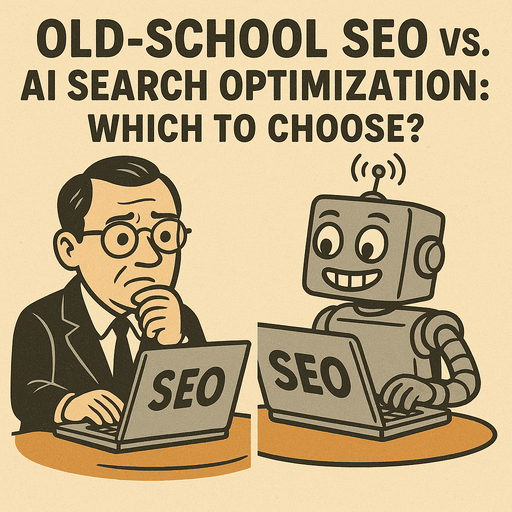
Short Answer: Old-school SEO focuses on ranking in Google's traditional blue links using keywords, backlinks, and meta tags. AI search optimization is about structuring your content so it gets cited in AI-generated answers, summaries, and voice search. Both matter in 2025, and your best strategy is learning how to blend them.
Introduction
If you’ve been doing SEO the same way since 2012, dialing in your keywords, tracking rankings in Google Search Console, and building backlinks like it’s your full-time job, you’re not alone. And frankly, you’re doing better than most.
You’ve probably spent years mastering the art of getting your website to show up on page one. You’ve seen what works, you know what doesn’t, and you’ve built real visibility using tried-and-true tactics. So when people start talking about “AI search optimization,” it’s natural to roll your eyes a little. Another trend. Another buzzword. Another thing tech people are trying to shove down your throat, right?
But AI search isn’t replacing what you’ve built; it’s layering on top of it. It’s not about tossing your old-school playbook. It’s about learning how to get your existing content cited, summarized, and surfaced in new places people are looking, including Google’s AI Overviews, ChatGPT, Bing Copilot, and Perplexity.ai.
This guide isn’t here to scare you into changing everything. It’s here to show you how traditional SEO and AI search optimization can work together, and why you don’t have to choose between them.
Let’s break it down.
Key Takeaways
-
Traditional SEO still matters for ranking in Google’s classic blue-link results.
-
AI search optimization helps your content appear in AI-generated answers and summaries.
-
AI Overviews now replace or supplement many top-ranking positions in Google Search.
-
Structured, factual, and well-cited content performs best in AI-driven search tools.
-
Ignoring AI optimization can lead to zero visibility in AI surfaces, even if you rank well.
-
The winning strategy for 2025 is blending old-school SEO with AI search formatting.
What Is Old-School SEO?
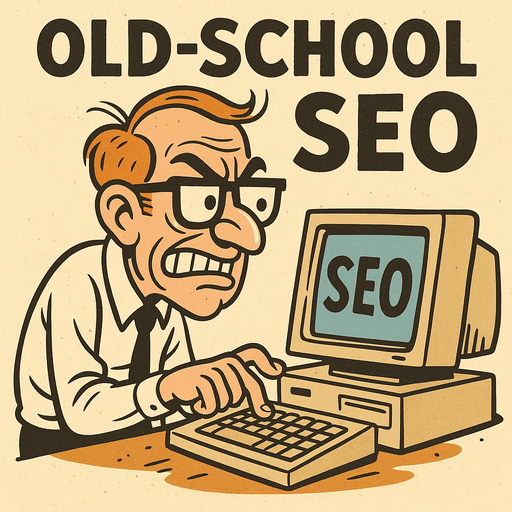
Old-school SEO, also known as traditional SEO, is the foundation of web visibility as we’ve known it for the past two decades. It revolves around principles that are still critical today, especially for businesses looking to rank in the classic "10 blue links" on Google's first page.
Keyword Research
At its core, old-school SEO starts with identifying keywords people are actually searching for. Tools like Google Keyword Planner, Ahrefs, and Semrush help content creators find high-volume, low-competition keywords. Once identified, these terms are naturally incorporated into:
-
Page titles and H1 tags
-
URL slugs
-
Body content (especially near the top)
-
Image alt text
-
Internal anchor text
In older SEO models, keyword density was often emphasized. Today, the focus has shifted to keyword relevance and contextual use, but foundational keyword research is still a pillar of SEO strategy. You can also plan for niche, long-tail keywords that don’t trigger AI Overviews and capture search value in less-competitive spaces (see “How to Optimize for Keywords That Don’t Trigger AI Overviews” for tactics).
(If you’re wondering how to modernize that approach, check out Does Keyword Density Still Matter for SEO? for a current look at how algorithms evaluate relevance today.)
Meta Tags and SERP Optimization
Traditional SEO involves optimizing meta titles and meta descriptions to influence click-through rates in search results. A strong meta title includes the primary keyword and stays under 60 characters. Meta descriptions (under 160 characters) provide a quick preview of the page content and often include a CTA.
On-Page Optimization
Proper use of heading tags (H1, H2, H3), descriptive image alt text, bolded focus phrases, and short, skimmable paragraphs all help search engines understand and rank your content. Structured HTML helps both bots and humans navigate your content more efficiently.
Internal Linking and Site Structure
Internal links pass authority between pages, helping search engines understand which content is most important. A strong internal linking structure also improves user experience and keeps people on your site longer.
Backlinks and Authority Building
One of the defining features of old-school SEO is its emphasis on link building. Getting backlinks from high-authority, relevant websites boosts your page's credibility in the eyes of Google. Tactics include:
-
Guest posting on industry sites
-
Earning links via valuable data or unique insights
-
Submitting your site to local directories and business listings
Technical SEO and Crawlability
Traditional SEO also includes behind-the-scenes work:
-
Creating and submitting an XML sitemap
-
Ensuring robots.txt isn’t blocking key pages
-
Compressing images to improve page load speed
-
Using schema markup for enhanced listings such as star ratings or event dates
-
Ensuring mobile responsiveness and HTTPS security
Measurable Results with GSC and GA4
Old-school SEO relies heavily on tools like Google Search Console (GSC) and Google Analytics 4 (GA4) to track:
-
Keyword rankings
-
Click-through rates
-
Impressions
-
Crawl errors and indexing issues
These tools remain essential even as AI search evolves. They show how your site performs in traditional search and help you measure content performance over time.
If someone Googles “emergency plumber in El Cajon” or “2026 Honda CR-V towing capacity,” they’re likely looking to click a link and take action. Traditional SEO helps you show up in those results.
But it’s not the only game in town anymore.
What Is AI Search Optimization?
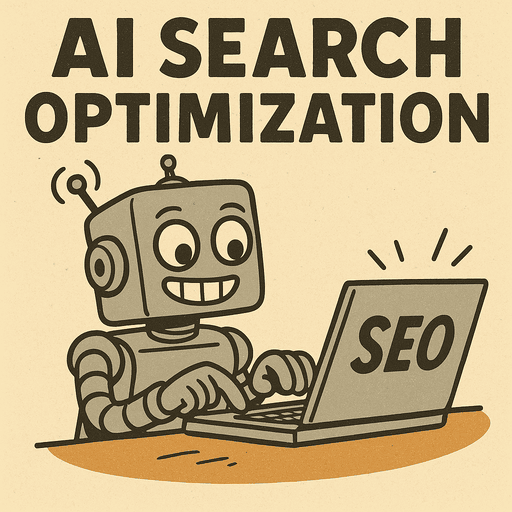
AI search optimization is a newer strategy designed to help your content get discovered and cited by AI-powered search tools, not just traditional search engines. These include:
-
Google’s AI Overviews
-
Microsoft’s Bing Copilot
-
ChatGPT’s Search Mode
-
Perplexity.ai
-
Voice assistants like Siri and Alexa
These platforms operate differently than standard web crawlers. Instead of indexing based purely on backlinks and keywords, they prioritize content that is clear, well-structured, and factually supported. Their goal isn’t to rank pages; it’s to deliver direct, conversational answers. That means the content that gets picked up is often:
-
Answer-focused and concise
-
Structured with headings, lists, and tables
-
Backed by credible, cited sources
-
Authored or reviewed by subject-matter experts
Short Answers and Structured Responses
AI search tools favor immediate answers. Placing a short, direct response at the beginning of your article dramatically increases the chance of being pulled into an AI Overview or ChatGPT citation. Think of it like writing for voice search: clear, natural, and to the point.
Question-Based Formatting
H2s and H3s written as questions make it easier for AI to match your content to user prompts. This formatting mimics natural language queries and allows generative tools to extract relevant chunks more easily.
Factual Claims and Source Citations
Content that gets cited in AI summaries typically includes verifiable, fact-rich information. Citing studies, government sources, or trusted industry publications gives your content a higher chance of being chosen and lowers the risk of AI hallucination.
Visual and Semantic Structure
Generative engines look for clean layout and organization. Using bullet points, step-by-step guides, comparison tables, and clearly labeled sections like “Pros and Cons” helps AI segment and summarize your content more effectively.
Entity-Based Optimization
AI search optimization moves beyond keywords. It focuses on entities such as things, places, people, and concepts. If your content establishes you or your business as a known entity connected to relevant topics (for example, SEO in San Diego, towing capacity, elder care), it builds contextual authority. AI tools pull from content that demonstrates depth across an entity cluster, not just shallow keyword mentions.
Content Trust and EEAT
To appear in AI answers, content must demonstrate Experience, Expertise, Authoritativeness, and Trustworthiness (EEAT). That includes:
-
Author bios and bylines
-
Medical or legal review when applicable
-
Factual consistency across your site
-
Backlink profiles from reputable domains
Does AI SEO Actually Work?
Yes, but not in the same way traditional SEO does. AI SEO works by improving your content’s discoverability in generative search engines and increasing your likelihood of citation within AI Overviews and conversational tools.
Unlike traditional SEO, you won’t always see a direct “click” in your analytics. Instead, the payoff is zero-click visibility—your brand or article being cited, quoted, or summarized directly in AI-generated results.
It’s especially powerful for:
-
Educational or exploratory searches like “how does AI affect small business marketing”
-
Top-of-funnel content that builds awareness
-
Brand credibility when your name or domain appears as a cited source
In fact, the concept of AI-First SEO isn’t just theoretical. According to a case study in my earlier blog Does AI-First SEO Work?, a private university deployed intent-based, answer-friendly content and saw 45.4 million impressions and 1.37 million clicks in under three years, including 27,000 clicks from blog content alone. This example proves that when you design content for AI and search in tandem, you can scale visibility far beyond what traditional ranking alone can achieve.
AI Visibility vs Traditional Rankings
According to Search Engine Journal, 54% of AI Overview citations overlap with traditional organic search results. That means having a strong SEO foundation still helps, but AI search optimization adds another layer of discoverability. The remaining 46% of citations come from pages that weren’t ranked in the top 10, a clear opportunity for smart formatting to outperform link-heavy competitors.
What Happens If I Ignore AI Search?
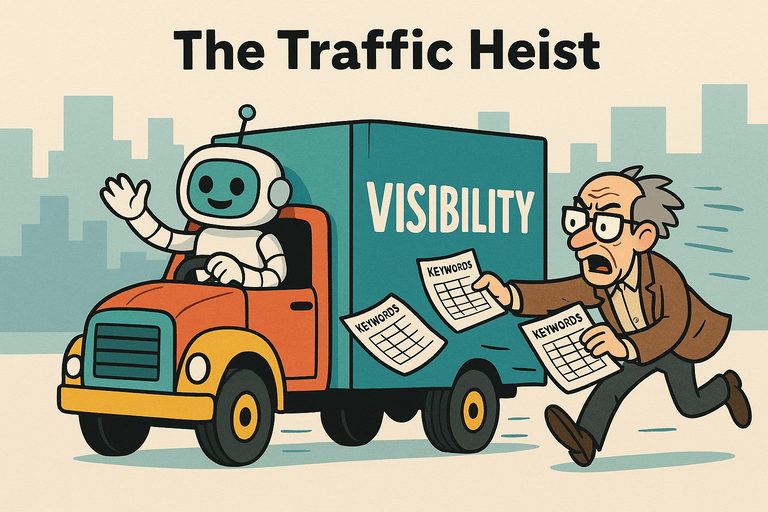
If you ignore AI search optimization, you risk becoming invisible on the fastest-growing surfaces of the internet.
Tools like Google’s AI Overviews, ChatGPT, Bing Copilot, and Perplexity are bypassing the blue links and summarizing content directly, often without a click. What used to be a top organic position is now being replaced by AI Overview citations, which appear above the first blue links and often answer the query before a user even scrolls.
If your content isn’t structured to be cited or summarized, it simply won’t appear in those AI-dominated positions, no matter how strong your SEO is.
That means:
-
Fewer impressions in zero-click environments
-
Missed traffic from AI summaries that pull from competitors instead
-
No visibility in conversational search tools or voice assistants
-
Reduced trust if you’re not showing up in answers
And even if your content ranks, it may be skipped by AI unless it’s formatted for answers. Traditional SEO alone won’t protect your reach.
AI search isn’t replacing Google; it’s sitting on top of it. Ignoring it won’t make it go away. It just means you’re handing the advantage to someone else who didn’t ignore it.
FAQ About Old-School SEO vs. AI Search Optimization

What is traditional SEO in 2025?
Traditional SEO refers to keyword-based optimization techniques designed to help pages rank in Google’s standard search results.
Is AI replacing SEO?
Not entirely. AI is expanding SEO by creating new surfaces where content appears, such as AI Overviews, summaries, and chat interfaces. Both approaches now work together.
Should I abandon old-school SEO?
Absolutely not. Old-school SEO remains the backbone of web visibility. AI search optimization builds on top of it rather than replacing it. Your best strategy is to keep optimizing for traditional search while formatting content for AI visibility—so you win in both spaces.
How do I know if my content is optimized for AI?
Look for short answers, clear formatting, citations, and question-based headers. You can learn more in this article about AI search optimization.
What’s better for visibility: SEO or AI optimization?
You need both. Studies show a 54% overlap between AI citations and organic rankings. But that also means 46% of AI answers come from content not ranking in traditional results.
What happens if I ignore AI search?
You risk losing visibility in new discovery channels where users get answers directly from AI. Even strong SEO pages may be skipped if they aren’t formatted for AI extraction.
Final Takeaway: Blend or Bet?
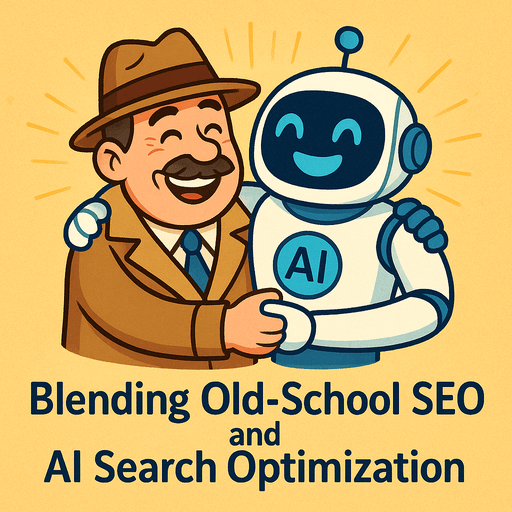
Don’t pick one. Blend.
If you only optimize for traditional SEO, you may rank but never get cited by AI.
If you only write for AI tools, you may get summarized but lose traffic from transactional clicks.
The smartest strategy in 2025 is to write content that does both:
-
Readable for humans
-
Scannable for AI
-
Trustworthy for both
Old-school SEO isn't dead. It's evolving. When you pair traditional techniques with AI-friendly formatting, you multiply your visibility across every channel that matters.
Need help optimizing your content for both blue links and AI summaries? Contact me for a hybrid SEO strategy tailored to your site.

0 Comments Add a Comment?